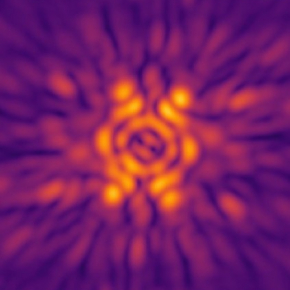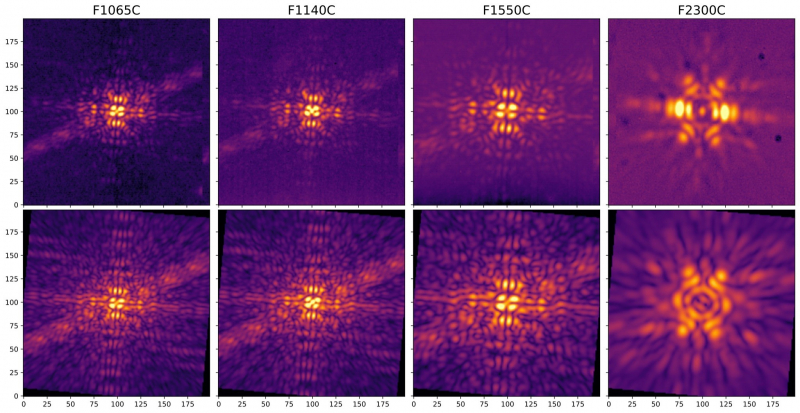Nine months after its launch, the James Webb Space Telescope provides unprecedented images of an exoplanet, the first ever obtained in the mid-infrared. These images should revolutionize our knowledge of extrasolar worlds. A team of French astronomers has been involved in the observations of this planet and in the design of the coronagraphs of the telescope.
Launched on December 25, 2021, the James Webb completed its test phase in July 2022. The science programs have since begun and are already producing their first results, including the first image of an exoplanet obtained in the mid-infrared: HIP 65426 b. It is a very young giant exoplanet, about 15 million years old, located at 90 astronomical units from its star. With an estimated mass of about 7 Jupiter masse, it had been discovered with the European instrument Sphere at the Very Large Telescope in 2017. The instruments of the James Webb now make possible its direct observation in the infrared.
HIP 65426 has just been observed by the NIRCAM and MIRI instruments in the framework of the "Early Release Science" (ERS) program led by an international collaboration including several French researchers from the CEA/Irfu/DAp-AIM, IPAG, LAM, LESI, and J-L Lagrange laboratories. MIRI is the only mid-infrared instrument of the James Webb. It was designed in part by a consortium of French laboratories led by the DAp-AIM laboratory. It contains a coronagraph system that reduce significantly the light coming from the star, allowing us to image exoplanets around it and to study their atmosphere. MIRI's coronagraphs are based on a new technology invented by the Observatoire de Paris-PSL that achieve better performances than initially expected. The recent publication of these results shows that stellar light can be attenuated by a factor of 10 000 to 100 000. These coronagraphs operate at wavelengths of 10.65 μm, 11.40 μm, and 15.50 μm, chosen specifically to probe the atmosphere of giant exoplanets, identify molecules such as ammonia, completing ground-based near-infrared observations.
The data collected on HIP 65426 b provide the first reliable measurement of the temperature in the atmosphere of this exoplanet: 1400°C. This corresponds to the temperature of the flame of a lighter. We expect that small grains of silicate dust will form and remain suspended in the atmosphere of the planet. JWST thus demonstrates its potential to study in detail the physico-chemical properties of these extrasolar worlds and to better understand their formation. The images could also reveal new planets still unknown in these systems.
These spectacular images are the first of the ERS 1387 program, entirely dedicated to direct observations of nearby planetary systems. The researchers will study a system younger than ours by 5 million years, around which there is still a lot of gas and dust to determine if these dusts contain water ice like comets in our solar system.
articles:
- The JWST Early Release Science Program for Direct Observations of Exoplanetary Systems I: High Contrast Imaging of the Exoplanet HIP 65426 b from 2−16 µm (Carter et al. 2022)
- JWST/MIRI coronagraphic performances as measured on-sky (Boccaletti et al. 2022)
To know more :
- website in French JWST France
- STScI(Space Telescope Science Institute) website in Baltimore.
Contact Irfu: Pierre-Olivier Lagage
Contact LESIA:
• Structure and evolution of the Universe
• Institute of Research into the Fundamental Laws of the Universe • Department of Astrophysics (DAp) // UMR AIM
• JWST





